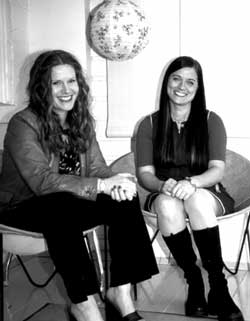YOU’RE A LOCAL artist. You’re doing OK in what Tom Wolfe calls the Boho Dance, respected in your own arty, low-budget circles, and showing occasionally at indie galleries like SOIL and SAW. But unless you achieve the second stage that Wolfe describes, the Consummationrecognition in the wider world, media attention, institutional validationyou may never have a lasting record of your work. It won’t be professionally photographed, slickly laid out, and accompanied by the kind of high-minded art talk you read in museum catalogs and art magazines (“Joseph Schmoesky, through his subversive appropriation of stereotypes and use of unorthodox materials, blurs the lines between sculpture and painting while calling into question the values of a consumer society . . . “).
At least that’s the way it used to be. The independent curator group Thread is, for better or worse, confounding and collapsing the Boho Dance and the Consummation. They are documenting, in the publications that accompany their exhibits, dozens of emerging Seattle artists (along with the occasional established old guy like Charles Krafft), thereby bestowing a kind of institutional legitimacy without the actual institution. Well, Thread is a kind of institution, but it’s made up of only two people: former Henry curator Rhonda Lane Howard and graphic designer Rebecca Richards, who run their shoestring operation out of a small office on Eastlake above the Four Seasons Cleaners.
Thread was founded in early 2002 as a way to be more immediately responsive to contemporary art than is possible in a museum. “I saw myself at the Henry forever,” says Howard, “but where it used to be a little red sports car, it had become a yellow school bus. It was harder to push ideas throughshows have to be planned one to four years ahead.” Howard and Richards, who keep the water on through their design and consulting services while running Thread as a nonprofit, describe the city’s artists with words like “incredible” and “amazing.” They are on a mission to make the world see these artists as they do, with results that are unfailingly professional looking, though not always convincing.
THREAD PROJECTS TO date include a gorgeously produced catalog of “Lava 2002,” last year’s Noodleworks show of 35 Seattle artists; Abfall, a book on local collage artist Robert Yoder; and, over Labor Day weekend, the “Fashion Is Art” runway show and exhibit of conceptual garments at Bumbershoot, also immortalized in a book (and currently on display at several Seattle clothing shops, such as Kuhlman in Belltown and Duque Duque in Ballard). Howard has written many essays for museum publications and Richards designs materials for the Henry and other arts organizationsin other words, they have mastered the look and the language of legitimacy from the inside and have devoted their skills to those on the outside.
“It’s nice to have a record that says, ‘Here was Seattle in this time period,'” says projection and performance artist Juniper Shuey. “It sort of ups the ante, because you’re not just presenting to your friends but also [doing it for] this lasting document.” Shuey has appeared in two of the three Thread publications.
If a curator’s job can be thought of as part cheerleader and part gatekeeper, Thread is definitely keener on the first part. Howard emphasizes the egalitarian, artist-driven nature of their productions, as opposed to the top-down selection process in the museum world she left behind. Undermining curatorial authority may be a hot topic at the moment (the theme of the 2003 Venice Biennale is “The Dictatorship of the Viewer”), and there is no doubt that Thread’s democratizing of professional-grade production values has brought a huge shot of positive energy to our sleepy little art scene. There’s a peppy, optimistic, thoroughly un-Seattleish quality to the whole enterprise that is impossible to resist. But I do hope that Thread’s pendulum will eventually swing back toward the gatekeeper side of its identity.
THE ESSAYS IN the Thread books (written by, among others, artist and writer Fionn Meade, the Henry’s communications manager Anna Fahey, and Howard herself) too often puff and strain to prop up mediocre workthe jokey promotion of the motorcycle helmet as a fashion accessory by Dylan Bolles and Nathan Lynch in the “Fashion Is Art” show, for one example (and there are plenty others). “They’ve achieved a funny way of illustrating their own objectification,” according to the catalog, but the result was a lot less funny than an Old Navy commercial and went on a lot longer. (You can now admire the helmets in the window of the Hugo Boss shop downtown.) If Thread had steeled itself to say no to about half the “Fashion” artists, some of the really fantastic stufflike the profoundly hilarious “Fashion Is Subterranean” by Claudia Fitch and Stephanie Skura and the inflatable suits in Sami Ben Larbi’s “Fashion Is Self”could have shone through more brilliantly.
Seattle may yet have an art scene that really can be described as “incredible” rather than “burgeoning.” For Howard and Richards to help it to get there may require them to trade in some of their Seattle nice for a bit of the museum-style elitism they left behind.








